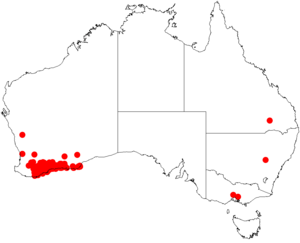Flat wattle facts for kids
Quick facts for kids Flat wattle |
|
|---|---|
 |
|
| Scientific classification | |
| Genus: |
Acacia
|
| Species: |
glaucoptera
|
 |
|
| Occurrence data from AVH | |
Acacia glaucoptera, also known as flat wattle or clay wattle, is a special type of Acacia plant. It grows only in the southwestern part of Western Australia.
Contents
Description
This plant is a shrub that can spread out or grow upright. It usually reaches a height of about 0.3 to 1.2 meters (1 to 4 feet) and can spread up to 2 meters (6.5 feet) wide.
The flat wattle produces bright yellow, round flowers. You can see these flowers from late winter to early summer. Its branches are smooth and mostly straight.
Instead of typical leaves, this plant has special flattened stems called phyllodes. These phyllodes are connected to the branches and form opposite wings. Each phyllode is usually 2.5 to 7 centimeters (1 to 2.8 inches) long and 0.6 to 2 centimeters (0.2 to 0.8 inches) wide. The free part of the phyllode is typically 1 to 4 centimeters (0.4 to 1.6 inches) long.
The flowers grow in small, round clusters. Each flower cluster is about 5 to 6 millimeters (0.2 inches) across and holds 30 to 80 golden flowers. After the flowers bloom, the plant forms black, smooth seed pods. These pods are twisted and coiled, growing up to 2 centimeters (0.8 inches) long and 2 to 3 millimeters (0.08 to 0.12 inches) wide. Inside the pods, the seeds are arranged lengthwise. They are oblong and measure about 2.5 to 3.5 millimeters (0.1 to 0.14 inches) long.
Taxonomy
Taxonomy is the science of naming and classifying living things. The flat wattle was first officially described by a botanist named George Bentham in 1855. He wrote about it in a scientific paper called Plantae Muellerianae: Mimoseae.
Later, in 2003, another botanist, Leslie Pedley, reclassified it. He moved it to a different group called Racosperma glaucopterum. However, in 2006, it was moved back to the Acacia group. Other names that have been used for this plant include Acacia bossiaeoides and Acacia sinuata. These are called synonyms, meaning they are different names for the same species.
Acacia glaucoptera looks a lot like Acacia pterocaulon. However, it is more closely related to other species like Acacia bifaria, Acacia excentrica, and Acacia merrallii. Interestingly, these related species do not have the winged branches that the flat wattle is known for.
Distribution
The flat wattle is found across a large area in Western Australia. You can find it in the southern parts of the Great Southern, Wheatbelt, and Goldfields-Esperance regions.
Its range stretches from Arthur River in the west and north, all the way to Esperance in the east and south towards the coast. This plant prefers to grow in gravelly clay soils, especially those rich in laterite. It often grows in areas with woodlands, tall shrublands, and mallee communities.
Cultivation
People often grow the flat wattle because of its unique "foliage." Its "leaves" are actually those special flattened stems called cladodes.
If you want to grow this plant, it needs soil that drains well. It also benefits from occasional pruning, which means trimming it to remove any dead parts. The flat wattle is quite tough and can handle cold temperatures, even down to about -7 degrees Celsius (19 degrees Fahrenheit).
See also
 In Spanish: Acacia glaucoptera para niños
In Spanish: Acacia glaucoptera para niños

